Object Record
Images
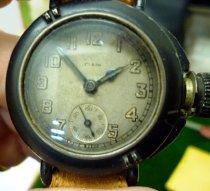
.jpg)
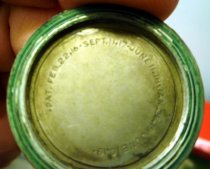
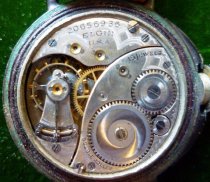
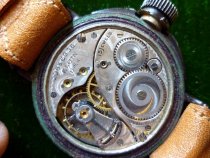
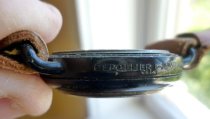
Additional Images [12]
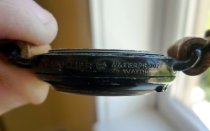
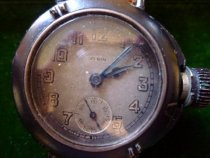
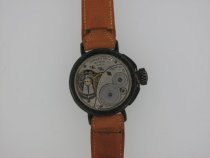
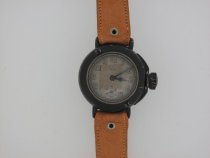
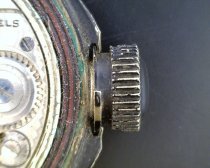
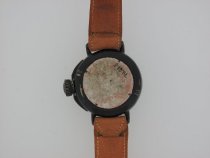
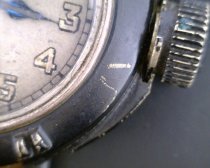
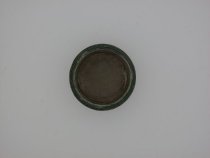
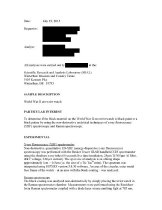

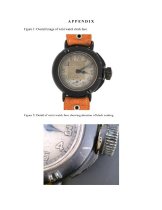
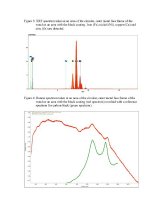
Metadata
Object Name |
Wristwatch |
Catalog Number |
78.61.8 |
Collection |
Watch |
Date |
c. 1920 |
Description |
Brief description: Nickel case, manual winding, detached lever wristwatch Round silvered white metal Arabic dial with luminous (radium) hands, sunk subseconds at 6 o'clock, marked ELGIN Crown (lockable) at "3" winds and sets hands Case a rare dustproof and waterproof "DEPOLLIER" with locked-down crown, bezel, and back screwed down Producer name: Elgin National Watch Company Production date: 1917 (based on movement) Made in: Springfield, Illinois, USA Dimensions: 35 millimeters (case) Markings: Dial: ELGIN Movement: ELGIN USA, 15 Jewels, 20,653,936, DOUBLE ROLLER Case (inside): "Patent Feb 22 1916. Sept 11 1917. June 11 1918. Jan 28 1919. June 10 1919." Case (side): DEPOLLIER TRADEMARKED, WATERPROOF WATCH See Notes for additional information. |
Maker |
Elgin National Watch Company 1917 |
Place of Origin |
Springfield, Illinois, USA |
Notes |
Curator's comments: This is a very early (1919/1920 based on case patent) "dustproof and waterproof" case wristwatch. Patented and manufactured 10 years prior to the Rolex "Oyster," this watch by casemaker "Depollier" has both screwed-down case and crown. Auguste Jaques (Swiss citizen) and Charles L. Depollier (U.S. citizen) filed patent No. 1,172,601 on November 1915, and it was granted in Feb. 1916, for this fully waterproof and dustproof case with lockable crown, front bezel, and back case. The case has lugs on both the bezel and back to allow a tight securing to the middle of the three-piece case. Advertisements in The Outlook, dated 1919, show a picture of this watch with a "Waltham" movement. (Waltham went on to become Depollier, a case manufacturer and marketing company and main movement supplier.) The advertisement describes the watch as follows: The Depollier Waterproof and Dustproof Strap Watch FIELD AND MARINE Registered U.S. Pat. Off. The Depollier Waterproof Case now adopted by the Signal Corps of the United States Army for the saving of watch movements purchased during the war and for future use. Ordinary strap watches were not constructed to withstand the wear and tear of field duty. A heat-insulated disk* protects the delicate movement from the injurious body heat of the arm, which has a tendency to dry or gum up watch oil. *Sadly, the gold heat sink appears missing on the NAWCC piece. Depollier of 15 Maiden Lane, New York, was mainly a case manufacturer and marketing company that made an association with Waltham (movement manufacturer); hence, to find this "ELGIN" movement in a "Depollier" case is extremely rare. A similar "ELGIN" black Depollier case model, dated 1917-1919, can be seen in American Wristwatches by Edward Faber and Stewart Unger, page 163. A similar "ELGIN" black Depollier case model dated 1917, can be seen in Military Watch Encyclopedia (ISBN4-7663-3185-0) pages 309 and again headed "Depollier Waterproof - Elgin U.S. Army", page 66) A similar piece, also dated 1919, can be seen in Complete Price Guide to Watches (Engle, Gilbert, and Shugart, 2013), page 746. The same style Depollier case Illinois wristwatch can be seen in The Illinois Watch by Fred Friedberg, page 134 and the Depollier advertisements on page 135. ADDITIONAL IMPORTANT CURATOR'S NOTE: Depollier was a manufacturer of accessories for watches and a clever marketing company. It realized that: "A business in the precarious position of selling an unbranded, unrecognizable type of goods to a few jobbers is likely to be crippled at any moment if those jobbers choose to swing their purchases from one manufacturer to the other." Therefore, Jacques Depollier was determined to link his product with a proven manufacturer of wristwatch movements. After a study of the American watch field, the Waltham was found to fulfill all the requirements, and Waltham movements were promoted in Depollier's marketing and advertising campaigns. However, the article also states: "All these (Waltham/Depollier) goods the company sells direct to the retailers, to whom the company advertises. It also sells to the jobber when the latter demands their goods." We know for certain that Depollier marketed, advertised, and sold the complete wristwatch with a Waltham movement. However, we do not know exactly how these other companies' "Depollier" cased pieces came to exist, but they do exist in "rare" quantities, as confirmed in the references above. Three scenarios exist: (1) They may have been the "study" samples quoted above. (2) They could have been cased by the "jobber" because it clearly states above that: "It also sells to the jobber when the latter demands their goods." (3) A third option is that "the reason we see Elgin and Illinois movements from 1917 & 1918 in the "Waterproof and Dustproof" watches besides Waltham's is because the US Army changed out the movements for what was available. They had plenty of spares lying around from the war; there is even a rumor that the US Army ordered just the cases from Depollier and then used their own spare movements." -Stan Czubernat. Indeed, the above quoted Waltham advertisement alludes to this: "for the saving of watch movements purchased during the war and for future use." This watch is similar to NAWCC object ID: FIC2012.3. The case on this watch has the original painted black to eliminate reflection from a silvered or a nickel case at night. Black-painted dials became common as part of the War Department's specifications for wristwatches. To find original pieces with the original case paint is very rare, because the paint chipped and wore off the metal nickel case. In time, the "chipped" paint was then fully removed by the owner. Actually we can find the same locking crown patented by Waltham in 1912/14(A/G) and transferred to Depollier in 1916 (patent No's 1085857 & 1172601) This watch is a typical early example of an early mass-produced American wristwatch. The case has soldered fixed wire lugs to attach the strap versus spring bars fitted in later watches from the 1920s. The movement is an Elgin, 3/0, Model 2, Grade 419, detached lever, 15 jewels, and runs at 18,000 beats per hour. ACKNOWLEDGMENTS Printers' Ink, Bruce Bliven, July 1917 Stan Czubernat , option #3 curator's notes Robert Butler, date corrections |
